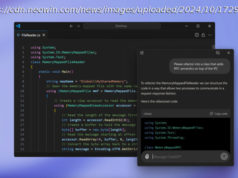Will Apple’s Amazon Echo competitor show up at WWDC 2017? We’ll find out soon.
After first appearing on phones, voice assistants entered the home in a big way with the Amazon Echo, a speaker that was equipped with Amazon’s Alexa voice assistant.
While Apple has had a voice assistant, Siri, on its phones for some time now, it has so far been left behind when it comes to smart speakers. Competitor Google brought its own voice assistant to dedicated hardware with the Google Home speaker last year.
Rumors have been circulating for a while now that both Microsoft and Apple are planning on bringing their voice assistants, Cortana and Siri respectively, to the home in the form of smart speakers.
We first heard reports of Apple employees testing the ‚Apple Speaker‘ in their own homes in September 2016, and another round of rumors suggests this home testing is still ongoing. More recently we’ve heard rumors that the speaker is actually entering production, making an imminent reveal looking ever more likely.
There’s also been word on the Apple street that the speaker is going to be shaped like a Mac Pro – just a bit smaller.
So, read on for all the information we have so far about Apple’s rumored smart speaker.
The most recent rumor points towards a launch in the second half of this year, in time for the Christmas shopping season, after an announcement at Apple’s annual developer showcase, WWDC, which this year takes place in June.
However we’ re slightly skeptical of this rumor for a couple of reasons.
First is the fact that WWDC is traditionally a conference where Apple talks about software rather than hardware, so talking about a new piece of smart speaker hardware would be highly unusual.
Secondly we’ re skeptical that the speaker would be announced as early as WWDC, only to be released much later in the second half of the year, as Apple likes to release hardware as soon as possible after it’s announced; each year the iPhone is released just 10 days after its initial announcement, for example.
There have been exceptions to this rule such as the AirPods, which released around three months after they were originally announced, but for the most part Apple maintains a fast turnaround between announcement and release.
Unfortunately this doesn’ t leave us with much of an idea about when the smart speaker might be coming, but after hearing that Apple employees are already testing prototypes in their own homes, and that the speaker is reportedly entering production, we’ re guessing it’s not far away .
Speculation is increasing that the speaker will indeed be shown off at WWDC though, complete with a touch panel, so perhaps Apple will spring a surprise.
Seven years ago, if you’d asked us what Apple would call this product we would have been certain that it would have called it the ‚iSpeaker‘. After all, back then the company had recently released the iPad, and prior to that it had brought out the iPhone, iPod, iTunes and iMac.
But nowadays the company’s naming scheme has shifted towards using the word ‚Apple‘ rather than the ‚i‘ prefix, pointing towards the new device being called the ‚Apple Speaker‘.
Recent products and services that have used the new naming scheme have included the Apple Watch, the Apple Pencil, Apple Music and Apple TV .
Even a tertiary initiative like the iTunes festival has been renamed to the Apple Music festival to reflect the new naming structure.
Given this change at Apple, we think it’s much more likely that the speaker will be called the ‚Apple Speaker‘.
If you want to get an idea of what an Apple Speaker would be capable of, then Siri on your iPhone is a good place to start.
Currently Siri is able to sync up with a number of the iPhone’s core features. It can add reminders to the reminders app, create events in the calendar app, set alarms and timers, call and video „Facetime“ call contacts, and find and read emails.
Siri is also heavily integrated into Apple HomeKit, which is the company’s home automation ecosystem, that allows you to control all of your connected devices from a single app. Using HomeKit you can have Siri turn on your lights, increase your home’s thermostat, or even activate a ceiling fan.
However, Siri has some significant problems compared to competing voice services.
For example, it heavily prioritises Apple’s own apps rather than allowing you to use alternatives. Ask Siri to play some music, and it will only be able to play songs that are located in your Apple Music app.
This is in contrast to both Alexa and Google Assistant, which both allow you to use a music app of your choice, rather than restricting you to Amazon Prime Music and Google Play music respectively.
Amazon has been especially open with allowing developers to integrate their services into its smart speakers. It allows the creation of ‘Skills’ which essentially act as apps for the smart speaker, and so far there have been over 10,000 of them created for the speaker.
On a basic intelligence level, Siri also has a number of problems. Ask it when the Mona Lisa was painted (the year 1503, art buffs) , and the voice assistant will happily tell you that ‘the answer is one thousand, five hundred and three,’ rather than being intelligent enough to realise that the year should be read aloud as ‘fifteen oh-three’ .
Of course there’s always the chance that Apple will put significant effort into improving Siri before the technology finds its way into a smart speaker. Google did a similar thing when it overhauled Google Now, creating Google Assistant, in the months before the Google Home was released.
Meanwhile, recent comments by Apple VP Phil Schiller suggest Apple is thinking along the lines of a Siri speaker with an integrated screen – so basically just a big iPad with better audio, then?
Previously, smart speakers focussed entirely on the voice, and recognising the commands that are spoken by the user.
However, there are some rumors that Apple’s rumored smart speaker might feature facial recognition via a built-in camera.
The technology could be used to recognise which users are interacting with the device, allowing it to cater to their individual preferences in music or lighting.
Over the past two years Apple has acquired the facial recognition startups Faceshift and Emotient, which suggests that such technology is something that the company is exploring.
Apple’s speaker would not be the first to feature a built-in camera. The recently announced Amazon Echo Look has a built in camera, which is used to recognise and recommend clothing choices.
Google Home recently added the ability to recognise users based on the sound of their voice, and we’ d imagine that Apple would want to feature similar functionality if it wants to compete with the existing major players in the market.
Related to the facial recognition capability is a recent rumor that the smart speaker will be able to recognise user’s emotions .
We’ re not entirely sure what this could end up adding to the overall user experience, but it’s funny to think that the speaker could theoretically play different music depending on how it reads your mood.
Another recent rumor points towards the device making use of ‘some form of Beats technology’ , although it’s unclear exactly what this could be.






